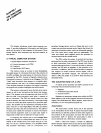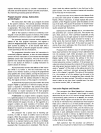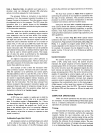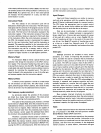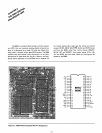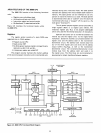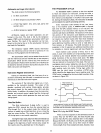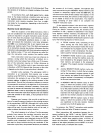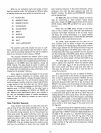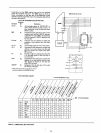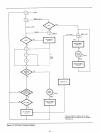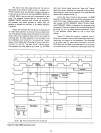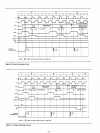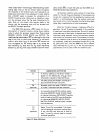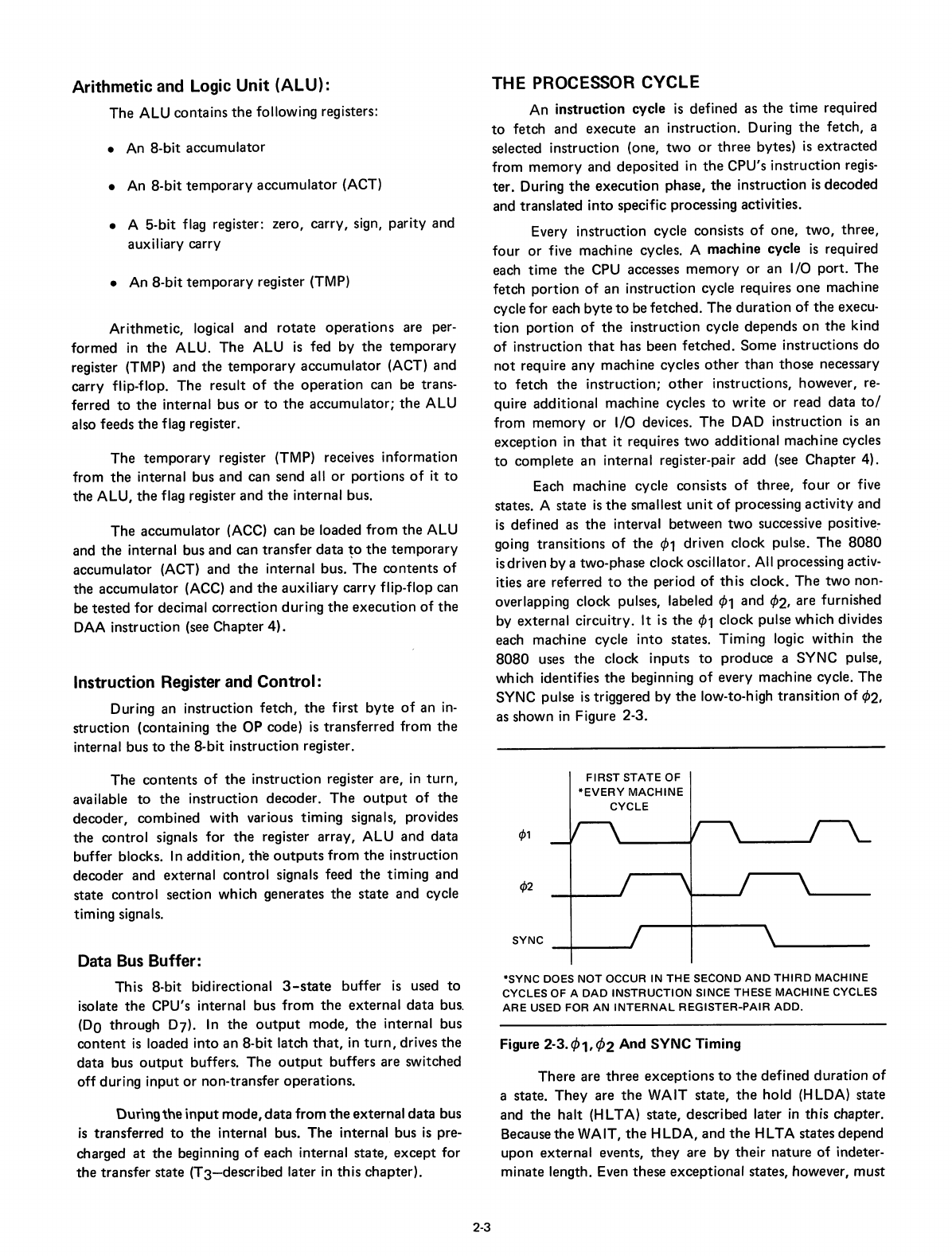
Arithmetic
and
Logic
Unit
(ALU):
The
ALU
contains
the
following registers:
• An
8-bit
accumulator
• An
8-bit
temporary
accumulator
(ACT)
• A 5-bit flag register: zero, carry, sign, parity
and
auxiliary carry
• An
8-bit
temporary
register (TMP)
Arithmetic,
logical
and
rotate
operations
are per-
formed
in
the
ALU.
The
ALU
is
fed by
the
temporary
register (TMP)
and
the
temporary
accumulator
(ACT)
and
carry flip-flop.
The
result
of
the
operation
can be trans-
ferred
to
the
internal bus
or
to
the
accumulator;
the
ALU
also feeds
the
flag register.
The
temporary
register (TMP) receives information
from
the
internal bus
and
can send all
or
portions
of
it
to
the
ALU,
the
flag register
and
the
internal bus.
The
accumulator
(ACC) can be loaded
from
the
ALU
and
the
internal bus
and
can
transfer
data
~o
the
temporary
accumulator
(ACT)
and
the
internal bus.
The
contents
of
the
accumulator
(ACC)
and
the
auxiliary carry flip-flop can
be
tested
for
decimal
correction
during
the
execution
of
the
DAA instruction (see
Chapter
4).
Instruction Register and Control:
During an instruction
fetch,
the
first
byte
of
an
in-
struction (containing
the
OP code)
is
transferred
from
the
internal bus
to
the
8-bit
instruction register.
The
contents
of
the
instruction register are,
in
turn,
available
to
the
instruction
decoder.
The
output
of
the
decoder, combined
with
various timing signals, provides
the
control
signals
for
the
register
array,
ALU
and
data
buffer blocks.
In
addition,
the
outputs
from
the
instruction
decoder
and
external
control
signals feed
the
timing
and
state
control
section
which
generates
the
state
and
cycle
timing signals.
Data
Bus
Buffer:
This 8-bit bidirectional
3-state
buffer
is
used
to
isolate
the
CPU's internal bus
from
the
external
data
bus.
(DO
through
07).
In
the
output
mode,
the
internal bus
content
is
loaded
into
an
8-bit latch
that,
in
turn,
drives
the
data bus
output
buffers.
The
output
buffers
are switched
off during
input
or
non-transfer
operations.
Dur\ng
the
input
mode,
data
from
the
external
data
bus
is
transferred
to
the
internal bus.
The
internal bus
is
pre-
charged
at
the
beginning
of
each internal state,
except
for
the
transfer
state
(T3-described
later in
this
chapter).
2-3
THE
PROCESSOR
CYCLE
An
instruction
cycle
is
defined as
the
time
required
to
fetch
and
execute
an
instruction. During
the
fetch, a
selected
instruction
(one,
two
or
three
bytes)
is
extracted
from
memory
and
deposited
in
the
CPU's
instruction
regis-
ter.
During
the
execution
phase,
the
instruction
is
decoded
and translated
into
specific processing activities.
Every
instruction
cycle consists
of
one,
two,
three,
four
or
five machine cycles. A machine cycle
is
required
each
time
the
CPU accesses
memory
or
an I/O
port.
The
fetch
portion
of
an
instruction
cycle requires
one
machine
cycle for each
byte
to
be
fetched.
The
duration
of
the
execu-
tion
portion
of
the
instruction
cycle
depends
on
the
kind
of
instruction
that
has been
fetched.
Some
instructions
do
not
require
any
machine cycles
other
than
those
necessary
to
fetch
the
instruction;
other
instructions, however, re-
quire additional
machine
cycles
to
write
or
read
data
to/
from
memory
or
I/O devices.
The
DAD
instruction
is
an
exception
in
that
it requires
two
additional
machine cycles
to
complete
an
internal register-pair
add
(see
Chapter
4).
Each machine cycle consists
of
three,
four
or
five
states. A
state
is
the
smallest
unit
of
processing
activity
and
is
defined as
the
interval
between
two
successive
positive~
going
transitions
of
the
¢1 driven clock pulse.
The
8080
is
driven
by
a two-phase clock oscillator. All processing activ-
ities are referred
to
the
period
of
th
is
clock.
The
two
non-
overlapping clock pulses, labeled ¢1
and
cP2,
are furnished
by external circuitry. It
is
the
cPl
clock pulse
which
divides
each machine cycle
into
states. Timing logic
within
the
8080
uses
the
clock
inputs
to
produce
a SYNC pulse,
which identifies
the
beginning
of
every machine cycle.
The
SYNC pulse
is
triggered by
the
low-to-high
transition
of
cP2,
as shown
in
Figure 2-3.
FIRST
STATE
OF
*EVERY
MACHINE
CYCLE
4>1
SYNC
*SYNC DOES
NOT
OCCUR IN
THE
SECOND
AND
THIRD
MACHINE
CYCLES OF A
DAD
INSTRUCTION
SINCE THESE
MACHINE
CYCLES
ARE USED FOR
AN
INTERNAL
REGISTER-PAIR
ADD.
Figure
2-3.1>1,</J2
And SYNC Timing
There
are
three
exceptions
to
the
defined
duration
of
a state.
They
are
the
WAIT state,
the
hold
(H
LOA) state
and
the
halt
(HLTA) state, described later
in
this chapter.
Because
the
WAIT,
the
HLOA,
and
the
HLTA states depend
upon
external events,
they
are
by
their
nature
of
indeter-
minate length. Even
these
exceptional
states, however,
must



